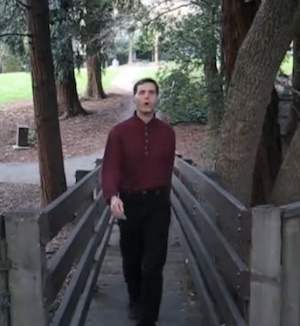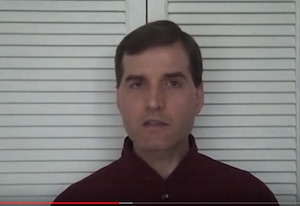Will “Language Shadowing” Work for You?
 When I first came across the language learning technique called “Shadowing”, I was intrigued.
When I first came across the language learning technique called “Shadowing”, I was intrigued.
In crime novels "to shadow" someone means to follow closely behind the person, watch what they do, where they go. Generally speaking, the idea is to gather some kind of information about the person or activity.
I recently described my 6 Listening Practice Tips for my Seventh Language. However, with the technique of "Language Shadowing", as practiced by Alexander Argüelles, you gather information to better imitate what you hear. And that can take you to the next level of your target language.
Language Shadowing Explained
It was the linguist Alexander Argüelles who in the 1990s developed Shadowing as a systematic technique for learning and practicing a language. He first used it for German and Korean and then for a number of other languages.
Argüelles has made three videos demonstrating and explaining Shadowing. They can be viewed directly on YouTube, or via his LinkedIn profile.
Video Number 1 (2008)
 This short video is just a minute long and shows Alexander Argüelles "Shadowing" Chinese while walking back and forth on a bridge. Here the three obvious features of his technique are:
This short video is just a minute long and shows Alexander Argüelles "Shadowing" Chinese while walking back and forth on a bridge. Here the three obvious features of his technique are:
1) listening and immediately repeating aloud
2) walking briskly outside at the same time
3) looking at the text intermittently
Video Number 2 (2009)
In this 13-minute video, Argüelles answers some questions viewers have asked about his first Language Shadowing video. For example:
• Does one need to walk back and forth and turn rapidly on a bridge?
His answer is "no". You can do it on a treadmill, but it's more pleasant to walk outside on a trail. The basic idea is to combine exercise with learning.
• Are the speed and motion necessary?
His answer: It works best for him. Moving about swiftly encourages you to say focused and maintain good posture. It's no mystery that correct posture and articulation are important for speaking well.
• Do you have to do Shadowing in public?
His answer: It's actually not ideal to practice it in public because one may feel self-conscious about walking around speaking aloud. And, people do come up to ask what you're doing. Still, he suggests it's not a bad way to deal with self-consciousness.
• How is it possible to say the foreign language "at the same time" as the native speaker?
His answer: You need to practice doing this. Repetition helps a lot and with time you'll get better. The goal is to listen and repeat a split second later as best as you can. (In the next video, Argüelles also calls this technique "echoing".)
Video Number 3 (2009)
 In the third video, which is just under an hour long, Argüelles goes over his Shadowing technique step by step and in considerable detail. As a number of language teachers and learners have pointed out, the technique of "listening and repeating" to learn a language is not an innovation made recently.
In the third video, which is just under an hour long, Argüelles goes over his Shadowing technique step by step and in considerable detail. As a number of language teachers and learners have pointed out, the technique of "listening and repeating" to learn a language is not an innovation made recently.
Children do it naturally when they learn their first language.
As a technique, listening and repeating (also called "parroting") became part of language teaching decades ago, before the internet popularized it with easily accessible audio.
However, Alexander Argüelles shaped the technique of Shadowing into a formal method with specific steps that he used to achieve his language learning goals. Early in the video he explains:
"Listen to [the audio] very closely through ear phones and make the sounds that you hear as soon as you hear them. ... You have to talk on top of the voice as you hear it coming. ... This will give you feedback. ... [Shadowing] proved for me to be the best ... means of starting to learn a language, of taking a language that you don't know and planting it, literally planting it inside your brain so that it can grow there."
Below is a brief outline of the steps or stages he describes. However, to really understand his method, you should look at the video Argüelles made. To learn by using Shadowing, you need a set of recordings with no pauses and a book that is bilingual with the text on opposite pages. The lessons should be short. To prepare for any Shadowing exercise, think in the language as best as you can.
As I understand them, there are 8 Stages to learning a language with Shadowing:
Stage 1: Blind Shadowing (15-20 min) of a lesson or lessons. This means repeating almost simultaneously even if you don't understand what's being said.
Stage 2: Do Shadowing while looking at the text of the teaching language.
Stage 3: Do Shadowing of the same text while looking back and forth between the teaching language and the target language to check the meaning.
Stage 4: Do Shadowing of the text while looking at the target language only.
Stage 5: Do Shadowing with brisk walking.
Stage 6: Sit down, look at the lesson(s) without audio and compare the texts in the two languages. Read the text aloud. Write the text of the lesson(s) out by hand.
Stage 7: Once you've finished the whole book, type out the entire text double-spaced. Read the text and fill in the meaning of words you don't know. You can do that several times. Add some grammar exercises.
Stage 8: Take the audio for a walk and Shadow it from start to finish.
Argüelles is quick to say that Shadowing is not the only technique or method he uses for learning and practicing a language. He has used and uses other techniques: reading, regular listening, listening while running, grammar practice, translation.
I should add that Argüelles is not your "regular" language learner. Often, he'll study many hours a day. He says he knows around 50 languages, and is featured in Michael Erard's book: "Babel No More. The Search for the World's Most Extraordinary Language Learners".
Experiences and Opinions
Looking for feed-back about Language Shadowing on the internet from other learners, I found a few voices and opinions (Several of them are in the answers to the question on Quora: "How effective is the shadowing technique to learn languages".)
Voices "For" Shadowing
• Richard deLong (on Quora) states that it helps intonation, pronunciation, and is good for "getting your mouth and brain back into the language."
• Phil Crimmins (on Quora) claims that you learn to mimic the emotional content of what is being said. It's like going to the gym for training your mouth muscles.
• Ivan Ottinger (on Quora) says it improves reaction speed for speaking.
• Alexandra Edlinger (on Quora) suggests that you can use it effectively for preparing specific situations, such as job interviews.
• A person with the name "clever clogs" (on LingQ Forum) finds that it helps to develop more natural rhythm and pace.
Voices "Against" Shadowing
• Steve Kaufmann (on LingQ Forum and YouTube video) clearly does not like the method. He says that it detracts from his enjoyment, that he doesn't like walking around briskly outside reciting what he's listening to, etc.
• Judith Meyer (on Quora) doesn't use Shadowing. The technique may "burn certain words or sentence structures into your mind" but she finds it less efficient than Spaced Repetition. She even doubts that Shadowing helps at all with fluency.
My Opinion
To follow Argüelles' method exactly seems like lot of hard work and not everybody has the commitment and discipline that he has. He says himself that it takes weeks to get the method down correctly.
I have not used Language Shadowing as a daily formal technique, though I have been doing "shadowing" (lower case) to improve my fluency in French, Spanish, and Italian. Repeating what I hear almost simultaneously and at conversational speech helps me to speak more naturally.
Argüelles uses the analogy that Shadowing is similar to a "video game", where you repeat many steps many times before you get to the next level. In his words: "You listen and speak many times, and do this again and again". He also suggests that once you've got the method down, you can experiment with it, and use it in a way that it works for you.
For me, using bits and pieces of the technique is a productive way of adding variety to my language practice. It's also a way I can really push myself to speak fast and at length. I'd love to hear about your take on Language Shadowing!
Bio: Ulrike Rettig is the co-founder of Gamesforlanguage.com. She is a lifelong language learner, growing up in Austria, the Netherlands, and Canada. You can follow her on Facebook, Twitter and Instagram, and leave any comments with contact or below.
